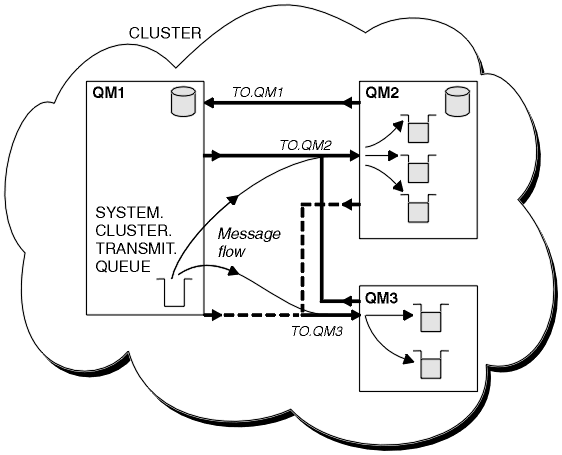What makes clustering work?
Defining a cluster-sender channel has the effect of introducing a queue manager to one of the full repository queue managers. The full repository queue manager updates the information in its full repository accordingly. Then it automatically creates a cluster-sender channel back to the queue manager, and sends the queue manager information about the cluster. Thus a queue manager learns about a cluster and a cluster learns about a queue manager.
Look again at Figure 1. Suppose that queue manager QM1 wants to send some messages to the queues at QM2. It knows what queues are available at QM2, because QM2 has defined a cluster-sender channel to it and so introduced itself. QM1 has defined a cluster-sender channel to QM2, on which it can send messages.
QM3 has introduced itself to QM2. Because QM1 also holds a full repository, QM2 has passed on all the information about QM3 to QM1. Therefore, QM1 knows what queues are available at QM3, and what cluster-receiver channel QM3 has defined. If QM1 wants to send some messages to queues at QM3, it automatically creates a cluster-sender channel connecting to the cluster-receiver channel at QM3.
Figure 1 shows the same cluster, with the two cluster-sender channels that have been created automatically. (These are represented by the two dashed lines that join with the cluster-receiver channel TO.QM3.) It also shows the cluster transmission queue, SYSTEM.CLUSTER.TRANSMIT.QUEUE, which QM1 uses to send its messages. All queue managers in the cluster have a cluster transmission queue, from which they can send messages to any other queue manager in the same cluster.
Figure 1. A cluster of queue managers, showing auto-defined channels
The auto-definition of cluster-sender channels—defined automatically when needed—is crucial to the function and efficiency of clusters. However, so that we can see only what we need to define to make clusters work, the diagrams throughout this book show only channels (or the receiving ends of channels) for which you make manual definitions.
Parent topic:
How queue manager clusters work
qc10770_
Home
